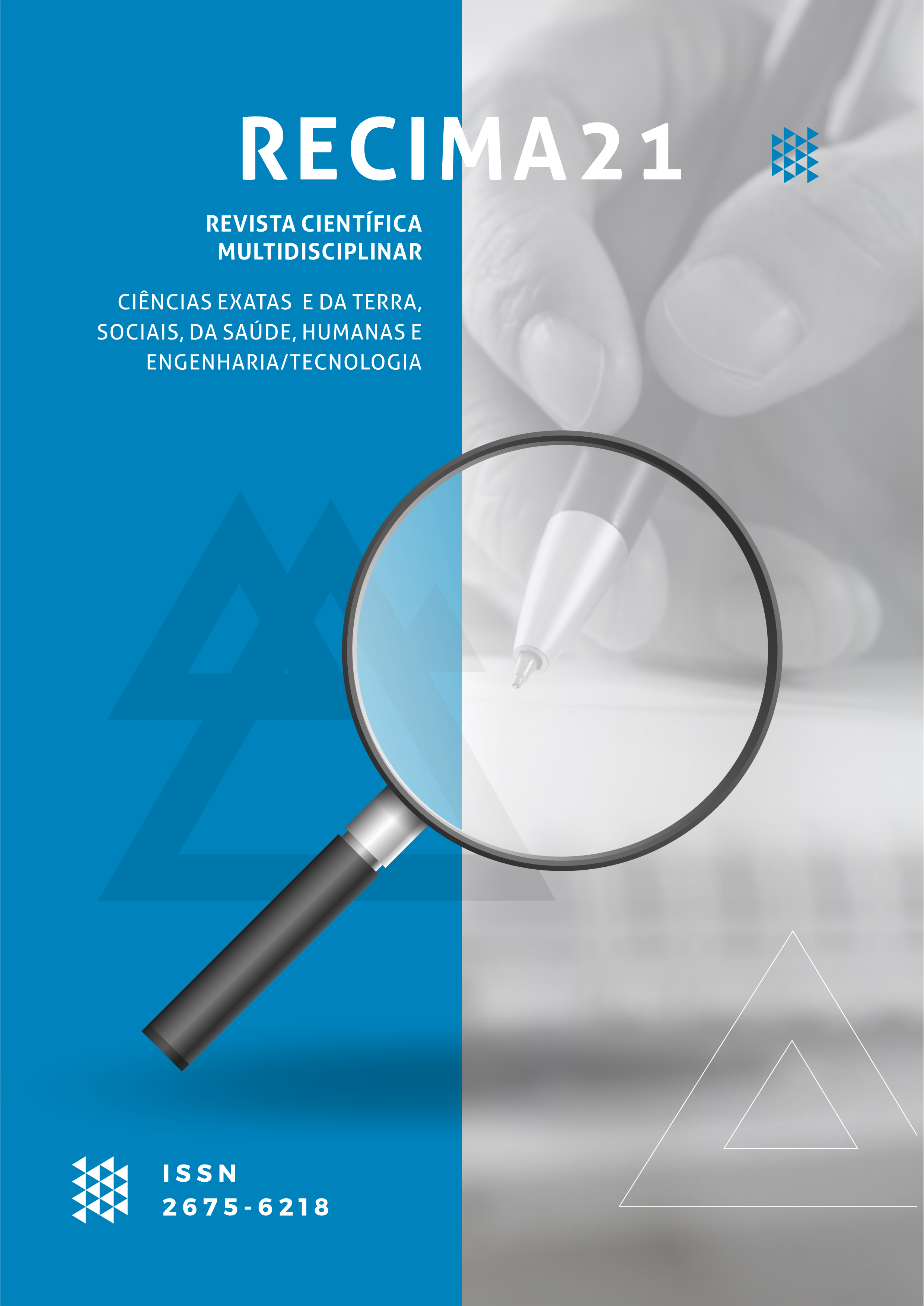DYSREGULATION OF microRNAs IN PATHOLOGICAL CANCER PROCESSES
DOI:
https://doi.org/10.47820/recima21.v3i12.2492Keywords:
miRNAs are endogenous molecules of approximatelyAbstract
miRNAs are endogenous molecules of approximately 25 nucleotides, these molecules are transcribed by RNA polymerase II, after transcription, microRNAs are processed by an RNAse III called DROSHA and a double-tape RNA binding protein DGCR8; DICER is associated with TRBP protein (RNA-binding protein responsive to gene activation) in the duplex cleavage of miRNA, with the proteins of the RISC-induced silencing complex causing post-transcriptional negative regulation of the target mRNA. miRNAs are involved in various biological processes, such as regulation of homeostasis and differentiation of the hematopoietic lineage, and are also related to pathological processes such as cancer and various other diseases. This study is an integrative review, the databases consulted were the NCBI, VHL, SciELO, and reference list of the selected articles, 156 articles were downloaded and only 36 were included in the review, with articles in Portuguese and English; we used the PRISMA 2020 flowchart to screen the articles. The findings demonstrated a wide range of interactions driven by a broad spectrum of proteins, positive and negative regulation of miRNAs has been associated with various types of cancer, these molecules can act as oncogenes or tumor suppressor genes and have become an attractive target for therapeutic studies, which could guide more effective mechanisms based on clinical decision-making as a prognosis, diagnosis and even as a non-invasive procedure.
Downloads
References
Abadi AJ.; Zarrabi A.; Gholami MH.; Mirzaei S.; Hashemi F.; Zabolian A. et al. Small in Size, but Large in Action: microRNAs as Potential Modulators of PTEN in Breast and Lung Cancers. Biomolecules. 2021; 11(304):1-31.
Bai X.; Liu Z.; Shao X.; Wang D.; Dong E.; Wang Y. et al. The heterogeneity of plasma miRNA profiles im hepatocellular carcinoma in patients and the exploration of diagnostic circulating miRNAs for hepatocellular carcinoma. Plos One. 2019; 14(2):e0211581.
Bernstein DL.; Jiang X.; Rom S. let-7 microRNAs: Their Role in Cerebral and Cardiovascular Diseases, Inflammation, Cancer, and Their Regulation. Biomedicine. 2021; 9:1-18.
Condrat CE.; Thompson DC.; Barbu MG.; Bugnar OL.; Boboc A.; Cretoiu D. et al. miRNAs as Biomarkers in Disease: Latest Findings Regarding Their Role in Diagnosis and Prognosis. Cells. 2020; 9:1-32.
Conti I.; Simioni C.; Varano G.; Brenna C.; Costanzi E.; Neri LM. MicroRNAs Patterns as Potencial Tools for Diagnostic and Prognostic Follow-Up in Cancer Survivorship. Cells. 2021; 10:1-15.
Conti I.; Varano G.; Simioni C.; Laface I.; Milani D.; Rimondi E. et al. miRNAs as Influencers of Cell-Cell Communication in Tumor Microenvironment. Cells. 2020; 9(220):1-28.
Datta A.; Das P.; Dey S.; Ghuwalewala S.; Ghatak D.; Alam SK. et al. Genome-Wide Small RNA Sequencing Identifies MicroRNAs Deregulated in Non-Small Cell Lung Carcinoma Harboring Gain-of-Function Mutant p53. Genes. 2019; 10:1-23.
Fan X-D.; Luo Y.; Wang J.; An N. miR-154-3p and miR-487-3p synergistically modulate RHOA signaling in the carcinogenesis of thyroid cancer. Bioscience Reports. 2020; 40(1):1-13
Ferneza S.; Fetsych M.; Shuliak R.; Makukh H.; Volodko N.; Yarema R. et al. Clinical signicance of microRNAs-200 and Let-7 families expression assessment in patients with ovariam cancer. ecancer. 2021. 15:1-17.
Fiala O.; Sorejs O.; Hosek P.;Liska V.; Vycital O.; Bruha J. et al. Association of miR-125b, miR-17 and Let-7c Dysregulation With Response to Anti-epidermal Growth Factor Recptor Monoclonal Antibodies in Patients With Metastatic Colorectal Cancer. Cancer Genomics & Proteomics. 2020; 17:605-613.
Filho JCMR.; Kimura ET. MicroRNAS: Nova Classe de Reguladores Gênicos Envolvidos na Função Endócrina e Câncer. Arq Bras Endocrinol Metab. 2006; 50(6):1102-1107.
Fortunato O.; Borzi C.; Milione M.; Centonze G.; Conte D.; Boeri M. et al. Circulating mir-320a promotes immunosuppressive macrophages M2 phenotype associated with lung cancer risk. International Journal of Cancer. 2019; 144:2746-2761.
Fu Y.; Liu X.; Chen Q.; Liu T.; Lu C.; Yu J. et al. Downregulated miR-98-5p promotes PDAC proliferation and metastasis regulating MAP4K4. Journal of Experimental & Clinical Cancer Research. 2018; 37:1-14.
Furtado FM.; Scheucher PS.; Santan BA.; Zanette DL.; Calado RDT.; Rego EM. et al. Comparison of microRNA expression B-cell lymphocytosis and Binet A chronic lymphocytic leukemia. Brazilian Journal of Hematology and Hemotherapy. 2017; 39(3):237-243.
Galvão-Lima LJ.; Morais AHF.; Valentim RAM.; Barreto J. S. S. miRNAs as biomarkers for early cancer detection and their application in the development of new diagnostic tools. Biomedical Engineering Online. 2021; 20(21):1-20.
Gayosso-Gómez LV.; Ortiz-Quintero B. Circulating MicroRNAs in Blood and Other Body Fluids as Biomarkers for Diagnosis, Prognosis, and Therapy Response in Lung Cancer. Diagnostics. 2021; 11(3):1-26.
Hilly O.; Pillar N.; Stern S.; Strenov Y.; Bachar G.; Shomron N. et al. Distinctive pattern of Let-7 family microRNAs in aggressive carcinoma of the oral tongue in young patients. Oncology Letters. 2016; 12:1729-1736.
Lan H.; Lu H.; Wang X.; Jin H. MicroRNAs as Potential Biomarkers in Cancer: Opportunities and Challenges. BioMed Research International. 2015; 2015:125094.
Larrea E.; Sole C.; Manterola L.; Goicoechea I.; Armesto M.; Arestin M. et al. New Concepts in Cancer Biomarkers: Circulating miRNAs in Liquid Biopsies. International Journal of Molecular Sciences. 2016; 17(627):1-42.
Li X.; Zhang X.; Ma H.; Liu Y.; Cheng S.; Wang H. et al. Upregulation of serum exosomal miR-21 was associated with poor prognosis of acute myeloid leukemia patients. Food Science and Technology. 2022; 42:e51621.
Li Y.; Zhou J.; Wang J.; Chen X.; Zhu Y.; Chen Y. Mir- 30b-3p affects the migration and invasion function of ovarian cancer cells by targeting the CTHRC1 gene. Biological Research. 2020; 53(10):1-8.
Nayak B.; Khan N.; Garg H.; Rustagi Y.; Singh P.; Seth A. et al. Role of miR-182 and miR-187 as potential biomarkers in prostate cancer and its correlation with the staging of prostate cancer. International Brazilian Journal of Urology. 2020; 46(4):614-623.
Pajares MJ.; Alemany-Cosme E.; Goñi S.; Bandres E.; Palanca-Ballester.; Sandoval J. Epigenetic Regulation of microRNAs in Cancer: Shortening the Distance from Bench to Bedside. International Journal of Molecular Sciences. 2021; 22(14):1-23.
Peng B.; Li C.; He L.; Tian M.; Li X. miR-660-5p promotes breast cancer progression through down-regulating TET2 and activating PI3K/AKT/mTOR signaling. Brazilian Journal of Medical Research. 2020; 53(12):1-10.
Piedade D.; Azevedo-Pereira JM. The Role of microRNAs in the Pathogenesis of Herpesvirus Infection. Viruses. 2016; 8(6):1-32.
Preethi KA.; Selvakumar SC.; Ross K.; Jayaraman S.; Tusubira D.; Sekar D. Liquid biopsy: Exosomal microRNAs as novel diagnostic and prognostic biomarkers in cancer. Molecular Cancer. 2022; 21:1-15.
Schubert M.; Spahn M.; Kneitz S.; Scholz CJ.; Joniau S.; Stroebel P. et al. Distinct microRNA Expression Profile in Prostate Cancer Patients with Early Clinical Failure and the Impact of let-7 as Prognostic Marker in High-RiskProstate Cancer. Plos One. 2013; 8(6):e65064.
Sereno M.; Videira M.; Wilhelm I.; Krizbai IA.; Brito MA. miRNAs in Health and Disease: A Focus on the Breast Cancer Metastatic Cascade towards the brain. Cells. 2020; 9(1790):1-27.
Silva EDP.; Marti LC.; Andreghetto FM.; Sales ROD.; Hoberman M.; Dias BDS. et al. Extracellular vesicles cargo from head and neck cancer cell lines disrupt dendritic cells function and match plasma plasma microRNAs. Scientific Reports. 2021; 11(18534):16.
Smolarz B.; Durczyński A.; Romanowicz H.; Szyllo K.; Hogendorf P. miRNAs in Cancer (Review of Literature). International Journal of Molecular Sciences. 2022; 23(5):1-18.
Takashima Y.; Kawaguchi A.; Iwadate Y.; Hondoh H.; Fukai J.; Kajiwara K. et al. miR-101, miR-548b, miR-554, and miR-1202 are reliable prognosis predictors of the miRNAs associated with cancer immunity in primary central nervous system lymphoma. Plos One. 2020; 15(2):e0229577.
Xie HH.; Huan WT.; Han JQ.; Ren WR.; Yang LH. MicroRNA-663 facilitates the growth, migration and invasion of ovarian cancer cell by inhibiting TUSC2. Biological Research. 2019; 52(18):1-9.
Yang N.; Zhu S.; Lv X.; Qiao Y.; Liu Y-J.; Chen J. MicroRNAs: Pleiotropic Regulators in the Tumor Microenvironment. Frontiers in Immunology. 2018; 9:1-12.
Yi M.; Xu L.; Jiao Y.; Luo S.; Li A.; Wu K. The role of cancer-derived microRNAs in Cancer immune escape. Journal of Hematology & Oncology. 2020; 13(25):1-14.
Záveský L.; Jandáková E.; Weinberg V.; Minár L.; Hanzíková V.; Dusková D. et al. Ascites-Derived Extracellular microRNAs as Potential Biomarkers for Ovarian Cancer. Reproductive Science. 2019; 26(4):510-522.
Zheng Q.; Zhu Q.; Li C.; Hao S.; Li J.; Yu X. et al. microRNA-144 functions as a diagnostic and prognostic marker for retinoblastoma. Clinics. 2020; 75:e1814.
Downloads
Published
How to Cite
Issue
Section
Categories
License
Copyright (c) 2022 RECIMA21 - Revista Científica Multidisciplinar - ISSN 2675-6218

This work is licensed under a Creative Commons Attribution 4.0 International License.
Os direitos autorais dos artigos/resenhas/TCCs publicados pertecem à revista RECIMA21, e seguem o padrão Creative Commons (CC BY 4.0), permitindo a cópia ou reprodução, desde que cite a fonte e respeite os direitos dos autores e contenham menção aos mesmos nos créditos. Toda e qualquer obra publicada na revista, seu conteúdo é de responsabilidade dos autores, cabendo a RECIMA21 apenas ser o veículo de divulgação, seguindo os padrões nacionais e internacionais de publicação.

 Clique para ver detalhes
Clique para ver detalhes 











